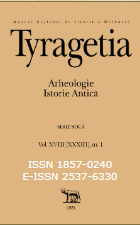Погребения позднего бронзового века из кургана 5 группы «север» у с. Глиное на левобережье нижнего Днестра
Late Bronze Age graves from barrow 5 of the “Sever” group near Glinoe village on the left bank of the Lower Dniester
Author(s): Sergey D. Lysenko, Sergey N. Razumov, Vitalii S. SinikaSubject(s): Archaeology, Cultural history, Social history, Prehistory
Published by: Muzeul Naţional de Istorie a Moldovei
Keywords: North-West Black Sea region; Dniester Region; Late Bronze Age; barrows; graves; pottery; gobletshaped vessels;
Summary/Abstract: The paper deals with materials from Late Bronze Age graves discovered in barrow 5 of the “Sever” group near Glinoe village, Slobodzeya district. The site is located on the left bank of the Lower Dniester, west of the watered Kremennaya Balka. The barrow was erected in one step in the Middle Bronze Age over the main burial (No. 3) of the Ingul Catacomb culture. Grave No. 1 of the Dnieper-Prut Babino culture was made later to the south of the center of the mound. Burial No. 2, dating back to the Sabatinovka time was the latest grave. It was made at the center of the mound, covering the entrance well of the main grave. The mound was surrounded by a ditch in Scythian times. Grave Glinoe/Sever 5/1 is typical of the Dnieper-Prut Babino culture of the microregion. In fact, it can be considered as a reference for a ritual group of strongly crouched burials, with the head resting to the east, with the position of the hands in the head/face area and with the placement of the vessel in front of the upper part of the body. The grave completely fits into the main interval of the existence of the Dnieper-Prut Babino culture – the 20th - 18th centuries BC according to the results of radiocarbon dating. Burial Glinoe/Sever 5/2 is quite unusual for the Late Bronze Age of the North-West Black Sea region. The buried person lies stretched out on his back, with his head to the east. The burial was accompanied by a bowl/goblet on a hollow conical foot and fragments of tubular bones of a small animal. The ornamentation of the cup has pronounced oriental (Andronoid, Fedorov-Cherkaskul) features. Two radiocarbon dates were obtained for the grave allowing it to be dated within the 15th - 14th centuries BC and attributed to the time of the developed Sabatinovka culture. Now, Glinoe/Sever 5/2 is the westernmost point of distribution of goblet-shaped vessels on a foot with eastern (Andronoid) features on the territory of the Great Steppe and adjacent regions in the space between the Dniester and Yenisei. The results of radiocarbon dating do not contradict the dating of existing analogues of similar ceramics, while allowing us to speak about its fairly early penetration far to the west.
Journal: Tyragetia (Serie Nouă)
- Issue Year: XVIII/2024
- Issue No: 1
- Page Range: 93-122
- Page Count: 302
- Language: Russian

